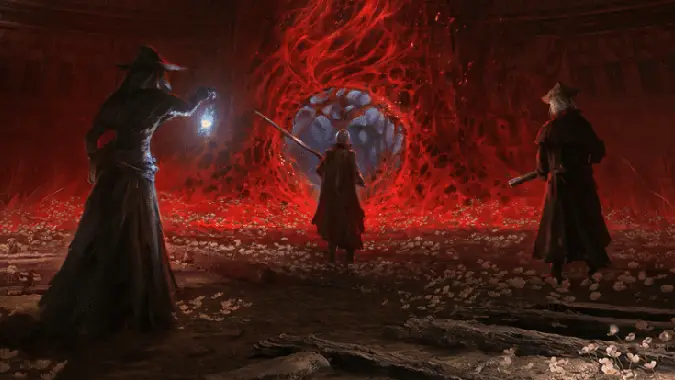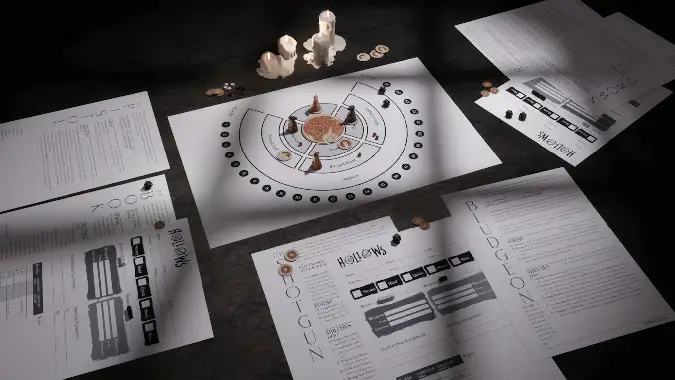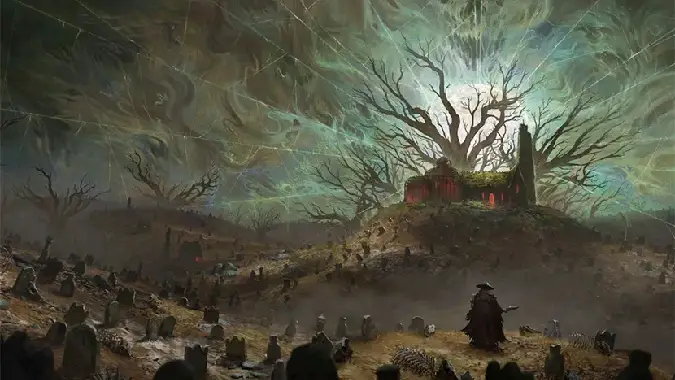Hollows is a dark, tactical TTRPG focused on thrilling boss fights

Hollows is a new tabletop RPG — currently under development by Rowan, Rook and Decard — that aims to make boss fights better and more satisfying. There are no mere goblins or kobolds here, the focus is generally on taking down one massive Entity at a time. If you’ve ever wanted to capture the epic feeling of a boss from a Souls-like game in a tabletop session, then Hollows may be right up your alley.
But Hollows is also a game about trauma, the people who suffer from it, and how it changes us. This can be a tough topic at any table, and the game treats both the players and its subject matter with respect, coming laden with content warnings and suggestions for how to handle difficult topics during play.
Let’s take a look at exactly what Hollows is and how it plays.
Hollows are personal hells, made to order
The Hollows setting
The Isles were once powerful and prosperous. An alliance of nations, acting under a stately royal family and a democratically elected parliament, its wealth and might were once the envy of the world. But the world is not what it once was, nor is it quite like ours. Floating just beyond of the veil of what its inhabitants call reality are the Malignancies, vast and terrible creatures picking at the seams of the universe, imparting their rank and putrid power into the hearts of those laden with enough trauma to make fertile ground.
After experiencing enough torment and horror, those seeds blossom into Hollows: cursed otherworlds infecting reality around them and making the rest of the world that much darker. Personal hells made to order, with their originators both Lord and prime captive, beyond the reach or influence of normal people.
Players in Hollows
Player characters take on the role of Hunters, who are not normal people. Hunters carry within them the ungerminated seed of a Hollow of their own, but unlike the Lords they are charged with slaying, they refuse to give in. Their tenacity not only allows them to break into Hollows, but makes them stronger, faster, and tougher — traits they’ll need to challenge the formidable Entities within. Hunters also carry Weapons, cursed, semi-aware instruments of pain and suffering that grow in power with the death of every monstrous Entity within a Hollow.
Most importantly, Hunters cannot truly die, or at least it doesn’t stick. When struck a fatal blow, a Hunter will quickly reawaken, unharmed, in their Sanctum, ready to rejoin their compatriots after their battle has concluded. Such power is not without price, however, for every rebirth strengths the seed of rot in their hearts, promising the creation of a twisted Hollow of their own one day.

Image courtesy of Rowan, Rook, and Decard
What makes Hollows different from other TTRPGs?
Hollows is a game about boss fights. While it does feature interludes of exploration and roleplay as the Hunters delve ever deeper into these malignant demenses, the combat is where most of the love and care put into the system shine through.
While most readers will be familiar with tactical, turn-based combat from other games such as Dungeons & Dragons 5E, Hollows does a few things differently, and to good effect. The first and most visible difference that players will notice is the tactical map on which the game is played. Unlike a standard square or hex grid, every zone on the Hollows tactical map is positioned in relation to the Entity that the Hunters are currently facing.
The Entity is always at the center, even as it charges and thrashes around the room. Changes in its position, or that of the Hunters, are reflected by moving the Hunters around it, whether it’s closer or farther away, or from the front to a flank. Deviances in terrain are abstracted through terrain tags, such as Elevated or Sheltered, which a Hunter can claim as a maneuver on their turn. This relativity of positioning creates a clean, consistent representation of the battlefield that allows for the players to think and orient themselves tactically without the need for specialized maps. It also has the neat psychological effect of reinforcing that the Entity is absolutely the center of attention for both the players and their characters.
The game also has different dice mechanics than you’re probably used to. While players will typically roll a single twenty-sided die when they attack, defend, or maneuver, the correct answer isn’t as simple as getting as high or even as low of a result as possible.
There are two critical values that go into every test players make: their relevant stat, and a target number relevant to the Entity or exploration encounter. The idea is that you want to roll a value that’s above the target number, but below your stat. Rolling below the target number is still a success, but only barely: a glancing blow against the Entity or a partial victory during an exploration. Rolling above your stat results in failure outright, or even a critical failure if you happen to roll a natural 20.
The game designers liken the system to blackjack, but personally I find a more useful touchstone to be the TV game show The Price is Right. You want to roll as close as possible to your stat without going over. Having a high stat value in relation to the Entity’s target number will make your rolls safer and give you a greater chance of a superior success.
The system takes a little bit to get used to after a lifetime of playing tabletop RPGs where higher rolls are always better or always worse, but it quickly becomes second nature after killing an Entity or two. Thankfully, there are still familiar ways to manipulate your roll if needed. Abilities that boost your stats or lower target numbers are always useful, and the advantage/disadvantage system from D&D 5E pays a visit as well.
Hunters and their Weapons grow in power as they carve a bloody swathe through the Hollows they invade, and the pace of advancement feels quite satisfying. Each of your Weapons start with one ability that empowers them as you enter a Hollow. These abilities are potent changes to each Hunter’s gameplay, such as granting advantage on attack rolls while the Entity is focused on you, or gaining a moderate stat boost when moving close up to it. Then, after each Entity you vanquish in the Hollow, you get to choose an additional ability to supplement your arsenal. Should you manage to vanquish the Lord of the current Hollow, not only do you close the horrifying pocket dimension and restore a little bit of safety to the world, but you also get to make one of your chosen abilities a permanent feature of your Weapon while the others fade away.
This cadence provides a quick and satisfying sense of progression without succumbing to incredible power creep, and it feels good.

Image courtesy of Rowan, Rook, and Decard
What Hollows currently offers
All this said, Hollows is a game that’s still very much under development. A quick start guide is currently available that provides the core rules and setting information, as well as five pre-generated characters and a single Hollow to play through. Other scenarios, character creation rules, and rules for advancement beyond gaining permanent Weapon abilities are still in development, making campaign play a little challenging at this point in time — but it’s still currently excellent material for a pick-up game with friends who like horror, tactical combat, and/or Souls-like games.
Personally, I had a blast when I got to playtest the game recently and I’m looking forward to trying it again when I have the opportunity and the source material has been further fleshed out. Hollows is developed by Rowan, Rook, and Decard and is available to back on BackerKit now.
Please consider supporting our Patreon!
Join the Discussion
Blizzard Watch is a safe space for all readers. By leaving comments on this site you agree to follow our commenting and community guidelines.




